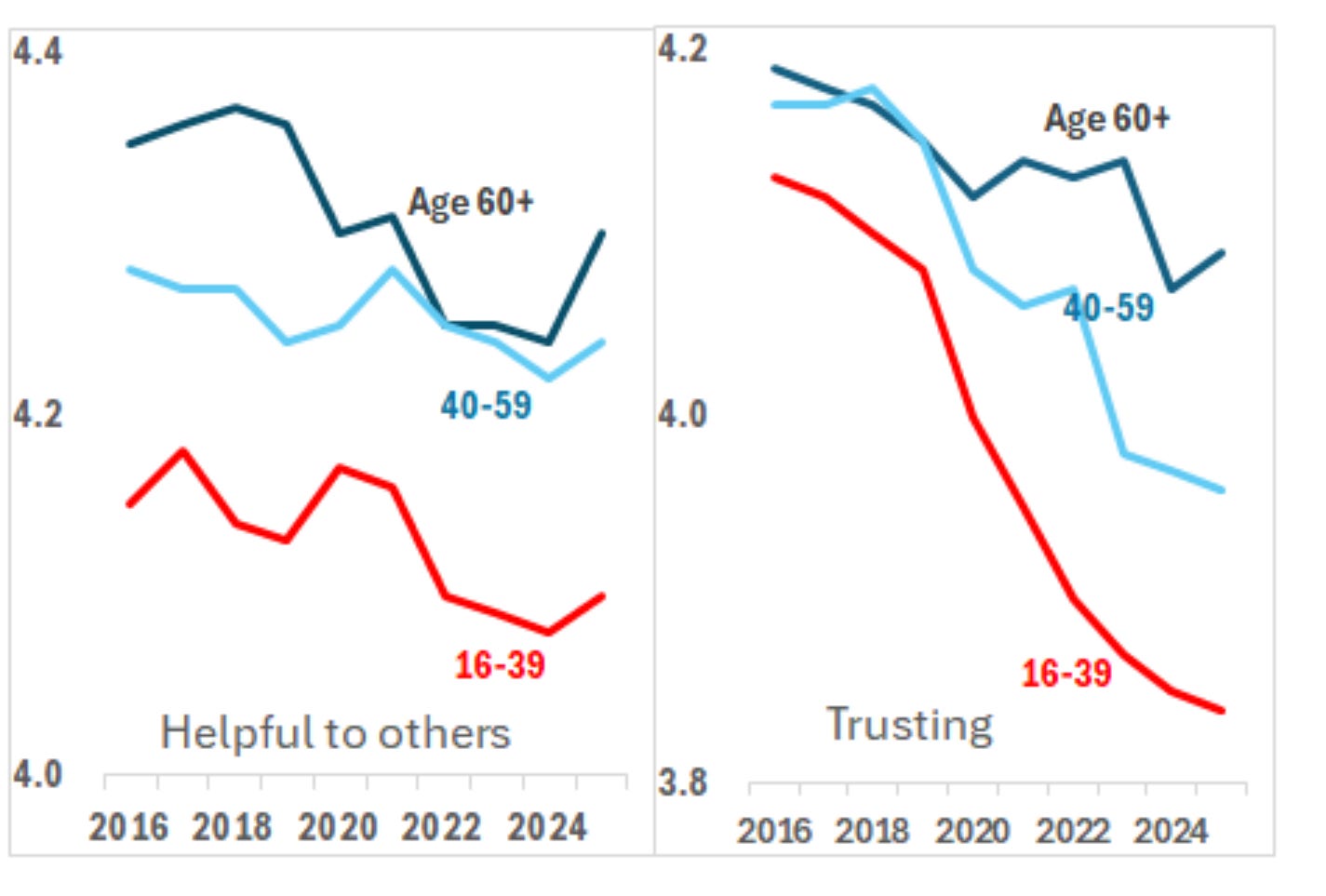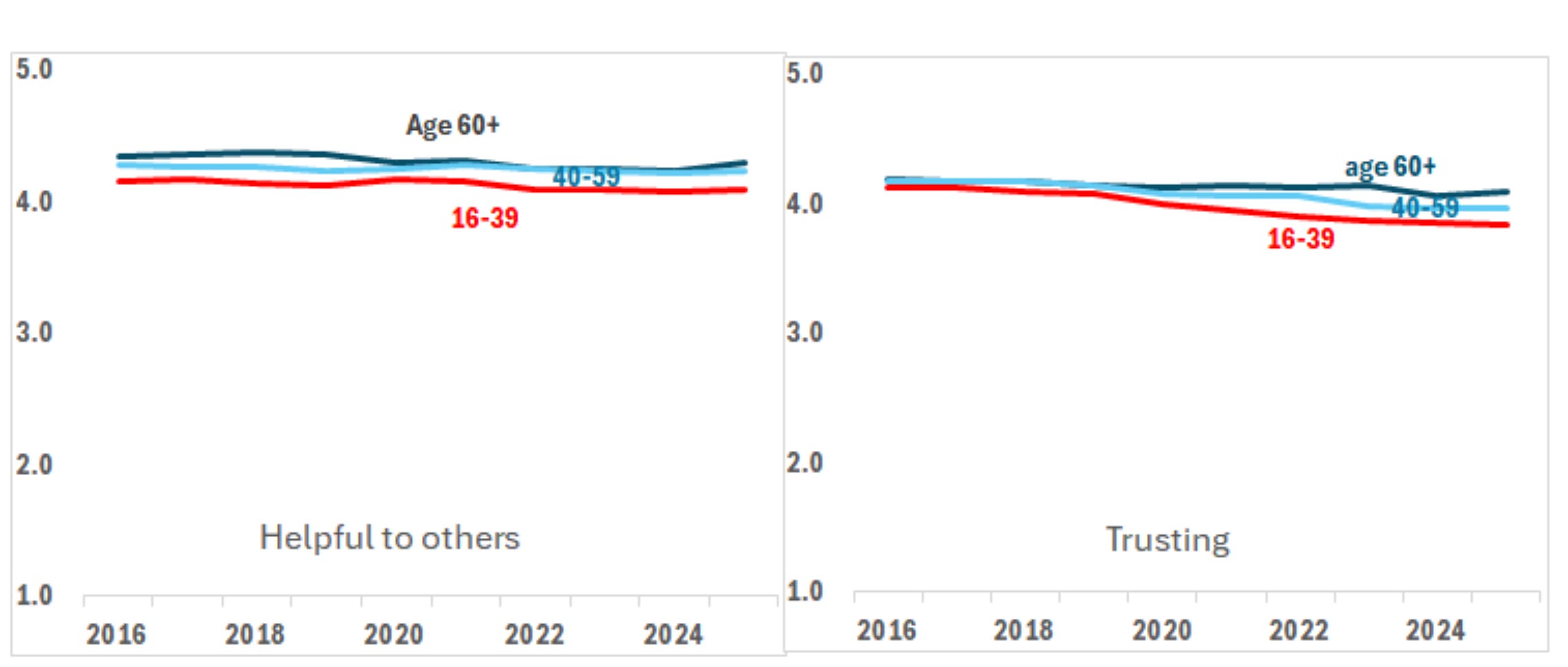How to go viral with dire-sounding – but phony – “statistical trends”
Those bent on creating anti-internet panics keep rigging their presentations.
"Breaking Points" August 11, 2025, alarmingly headlined: "Viral Chart EXPOSES Internet Fueled Personality Destruction,” with blaring subheads: "Studies show internet is ruining our cognitive abilities.” “Especially for young people,” podcast hosts Saager Enjeti and Krystal Ball warned, reeling off terrifying claim after claim about online perils (but somehow failing to foreswear that personality-destroying cognition-ruining internet themselves).
The evidence? Statistician John Burn-Murdoch of The Financial Times created charts from the Understanding America survey, which “Breaking Points” uncritically featured. Popular media presentations of the 2016-2025 trends, shown in the following charts for two key measures, certainly look frightening, illustrating a society in calamitous decline:
However, those who look closely for even a few seconds – certainly not Saager, Krystal, or other media sources I found – will notice two severe problems. First, the vertical axis showing averaged responses to questions on a scale of 1 to 5 is severely truncated in order to grossly exaggerate age differences and trends. Differences and trends are further embellished by presenting them in tall, narrow charts.
In contrast, below is a presentation of the same numbers in honest fashion, using the full 1 to 5 scale in figures that have equal vertical and horizontal dimensions:
Presented accurately, these statistics and trends would never have gone “viral.” They look like the near-nothings they are.
Psychologist and statistician Christopher Ferguson takes a deeper look at the Understanding America and Financial Times data and concludes: “No, conscientiousness hasn’t collapsed among young people in recent years.”
Further, neither media commentators nor the study in question even tries to show that “the internet” (as opposed to, say, reasoned assessments of real-world developments) is to blame for these minimal trends. Like social-media panickers, they just assume it must be – a highly arguable assumption, given that internet and social media use was well established back in 2016 when things were supposedly rosy.
Nor do they show whether, to cite the most salient trend, people of all ages (especially younger ones) might be acting rationally to be somewhat less trusting today than in 2016.
An individual, especially a younger one, might see our leading institutions are acquiescing and even backing genocidal foreign policy, doing nothing about climate change, widening economic inequality, financing more sumptuous lives for the privileged by dumping massive debt on young and future generations, and retreating back into openly Jim Crow racism, among other evils only barely anticipated back in 2016. That could be seen as untrustworthy and depressing, depending on one’s politics.
My humble assessment is that anyone who feels “trusting” today – along with anyone who is not getting more depressed at leaders’ rising brutalities and betrayals – is either not paying attention or brainlessly delusional.
But the point here is that even by the Understanding America data, the most salient decline in the averaged trust score, from around 4.1 in 2016 to 3.8 in 2025 on a scale of 1.0 (totally untrusting) to 5.0 (totally trusting) among ages 16-39, is hardly unexpected or catastrophic. The age 16-39 score in 2025 still approaches “strongly trusting,” well above the scale median of 3.0.
I don’t know how Burn-Murdoch characterized these data, and I’m not about to pay the firewall fee to find out. I’m more interested in how the “viral” media communicates them to the public. To listen to Saager and Krystal (and others) rant, we should immediately shut down the internet entirely, confiscate everyone’s cell phone, computer, laptop, and tablet, and mandate daily in-person coffee klatches and beer-bowling.
Either that, or inaugurate authorities’ and media’s critical responsibility on youth and culture-war issues, an American first, to replace the endless shrieking.
As I’ve documented repeatedly, young people were not better behaved, less troubled, thriving educationally, or more pro-social in pre-internet decades. In fact, they acted much worse than Gen Z does today.
Our top officials have refused – flatly – to pay any attention to what teenagers tell us on leading surveys is causing their depression and anxiety. Teens overwhelmingly cite household grownups’ abuses, violence, mental illness, and addiction – and self-aggrandizing authorities stubbornly refuse to listen. In this reality vacuum, demagogues blaming the internet and social media based on thin evidence have hijacked discussion, sabotaging badly needed confrontations toward real problems.
For the record: I am not affiliated in any way with social media, tech, or related interests, nor have I ever been paid by them. I despise Zuckerburg, Musk, Bezos, and the lot. Nothing here should be construed as approving of the way social media and tech moguls operate.






Mike it’s awful, and it’s a problem that infects almost the entirety of psychological “research” and much of physiology as well. Researchers have become intent on demonstrating a hypothesis and studiously avoid demonstrating the null. And the media laps up the flawed or hyped conclusions. And clients bear the brunt of stupid, useless, or harmful strategies that arise as a result of the whole mess.